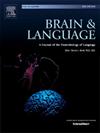Parafoveally perceived orthographic cues facilitate foveal semantic processing: Evidence from event-related potentials
IF 2.3
2区 心理学
Q1 AUDIOLOGY & SPEECH-LANGUAGE PATHOLOGY
引用次数: 0
Abstract
Readers extract information from words viewed parafoveally, but it is unclear whether this processing is limited to orthography or if it extends to lexico-semantic content. In the current ERP study, we measured the N400 responses to words that were perceived parafoveally and/or foveally using the RSVP-with-flankers paradigm and a parafoveal masking manipulation. We compared anomalous orthographically related (neighbor) and unrelated (non-neighbor) words to expected words to determine whether the N400 responses were driven by orthographic and/or semantic processing. We observed a large parafoveal N400 effect in response to the non-neighbors (versus expected), and a smaller, later parafoveal N400 for neighbors, suggesting that the parafoveal response is largely orthographic in nature. We also observed a significant reduction in foveal N400 magnitude when non-neighbor words were previously visible parafoveally (but not for the foveal N400 response to neighbors), suggesting that facilitation of foveal processing is driven by parafoveal detection of orthographic violations.
中央凹旁知觉的正字法线索促进中央凹语义加工:来自事件相关电位的证据
读者从准中央观看的单词中提取信息,但尚不清楚这种处理是否仅限于正字法或是否扩展到词汇语义内容。在当前的ERP研究中,我们使用rsvp - withflankers范式和旁中央掩蔽操作测量了N400对旁中央和/或中央感知词的反应。我们将异常正字法相关(邻接)词和不相关(非邻接)词与期望词进行比较,以确定N400反应是否由正字法和/或语义处理驱动。我们观察到对非邻居的反应有一个大的旁中央凹N400效应(与预期相比),而对邻居的反应有一个小的,晚的旁中央凹N400,这表明在本质上,旁中央凹的反应很大程度上是正交的。我们还观察到,当非相邻词在中央凹旁可见时,中央凹N400的幅度显著降低(但对相邻词的中央凹N400反应不明显),这表明中央凹处理的促进是由中央凹旁对拼写错误的检测驱动的。
本文章由计算机程序翻译,如有差异,请以英文原文为准。
求助全文
约1分钟内获得全文
求助全文
来源期刊

Brain and Language
医学-神经科学
CiteScore
4.50
自引率
8.00%
发文量
82
审稿时长
20.5 weeks
期刊介绍:
An interdisciplinary journal, Brain and Language publishes articles that elucidate the complex relationships among language, brain, and behavior. The journal covers the large variety of modern techniques in cognitive neuroscience, including functional and structural brain imaging, electrophysiology, cellular and molecular neurobiology, genetics, lesion-based approaches, and computational modeling. All articles must relate to human language and be relevant to the understanding of its neurobiological and neurocognitive bases. Published articles in the journal are expected to have significant theoretical novelty and/or practical implications, and use perspectives and methods from psychology, linguistics, and neuroscience along with brain data and brain measures.
 求助内容:
求助内容: 应助结果提醒方式:
应助结果提醒方式:


